The best whole home water filtration system for municipal tap water is the SpringWell CF. These are our top picks for the best POE water filters based on contaminant removal capability, capacity, quality, customer satisfaction, and of course affordability.
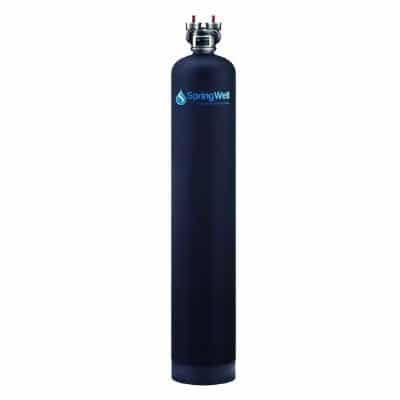
SpringWell CF
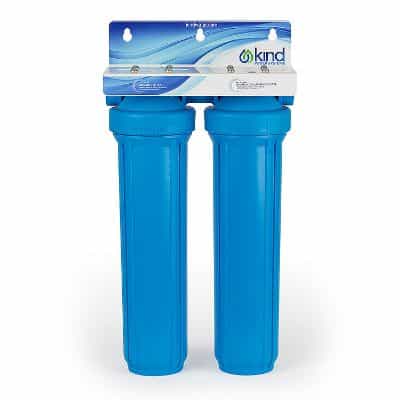
Kind E-1000
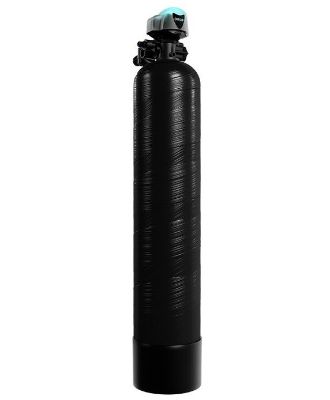
DROP Whole House Backwashing Filter
Looking for the best whole house water filter?
The market for point of entry water filters is growing, and we now have more choices than ever before. That’s great – but it does complicate the buying process, especially since not all filters are right for every home or situation. Plus, these are those that simply aren’t worth your money due to poor design or performance.
We’ve made this guide in the hope that it will serve as your go-to resource when choosing between the best whole home water filters, saving you hours of research along the way.
Below, we’ve shared the POE filters that we’ve found, after extensive research, testing, and comparison, to be better than any of the other filters available today. We’ve ranked the filters based on their contaminant removal abilities, durability, ease of use, customer feedback, and overall value for money.
Table of Contents
- 🥇 Best Whole House Water Filters
- 📊 Comparison Chart of Whole House Water Filters
- 🧾 How to Select the Best Whole House Water Filtration System
- ⚖️ How We Determined Which Whole House Water Filtration System Is Best
- 💭 Why Buy A Whole House Water Filtration System?
- 👍 Top 5 Advantages of a Whole House Water Filtration System
- 🛒 How to Buy
- 📚 Methodology: How We Picked The Best Whole Home Filtration Systems
- ❔ Frequently Asked Questions
- 🤓 About Our Experts
🥇 Best Whole House Water Filters
- Best for Municipal Tap Water: SpringWell CF
- Best Cartridge Based: Kind E-1000 Whole House Water Filter
- Premium Pick: DROP Whole House Backwashing Filter
- Best for Well Water: SpringWell WS
- Budget Tank System: SoftPro Whole House Upflow Carbon Filter
- Best Whole House Sediment Filter: RKIN CBS 5 Micron Sediment Whole House Filter
📊 Comparison Chart of Whole House Water Filters
| System | SpringWell CF | Kind E-1000 | DROP | SpringWell WS System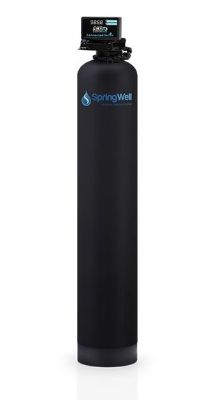 | SoftPro System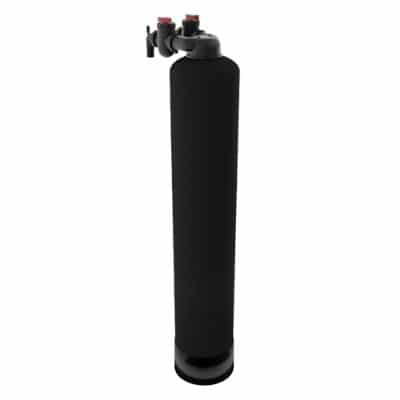 | RKIN CBS 5 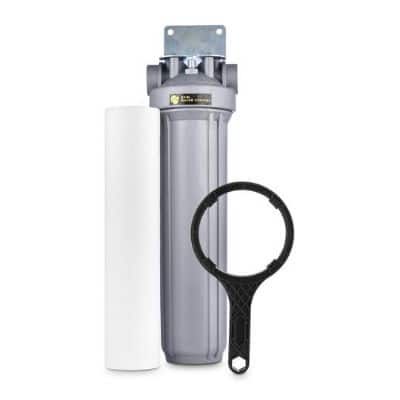 |
|---|---|---|---|---|---|---|
| Ranking | 1st | 2nd | 3rd | 4th | 5th | 6th |
| Ratings | 5/5 | 4.5/5 | 5/5 | 5/5 | 4.5/5 | 4.5/5 |
| Price | $1016.44+ | $776.12 | $1912.20+ | $2204.09+ | $847+ | $577.78 |
| Contaminants Removed | 10+ | 10+ | 10+ | 3 | 10+ | 4 |
| Capacity | 1M gallons | 80K gallons | 1M gallons | n/a | 600k or 1M gallons | 12 months |
| Flow Rate | 9-20 GPM | 15 GPM | 5-8 GPM | 12-20 GPM | 6-15 GPM | 20 GPM |
| App Connectivity | Yes | No | Yes | Yes | No | No |
| Annual Cost | ~$40 | $120 - $300 | n/a | <$150 | ~$40 | ~$50 |
| Warranty | Lifetime | Lifetime (limited) | 5 years | Lifetime | Lifetime | 1 year |

SpringWell CF
In our opinion, the SpringWell CF is the best overall whole house water filter for municipal water available today.
Specs
| Price | $1016.44+ |
| Contaminants Removed | 10+ |
| Capacity | 1,000,000 gallons |
| Flow Rate | 9 – 20 GPM |
| Annual Cost | ~$40 |
| App Connectivity | No |
| Warranty | Lifetime |
We concluded from our research and testing that the CF Whole House Water Filter System is the most capable and durable option compared to other systems on the market.
For instance, the system has a massive 1,000,000-gallon capacity, while others typically have lower capacities of 600,000-800,000 gallons. Plus, it reduced high levels of a range of harmful contaminants in our water (including lead and disinfection byproducts). It’s also designed to target a few contaminants that are notoriously difficult to remove, like chloramine and PFAS, although full disclosure, these weren’t in our water, so we can’t comment personally on its ability to remove them.
Best For
Anyone looking for one of the best value-for-money whole house water filter systems, manufactured by a trusted brand and backed by impressive lifetime warranty coverage.
What We Like
- Large 1,000,000-gallon capacity
- Efficient performance
- Removes a variety of contaminants
- Low-maintenance
What We Don’t Like
- Sediment filter needs replacing every 6 to 9 months
- Not all parts for installation are included
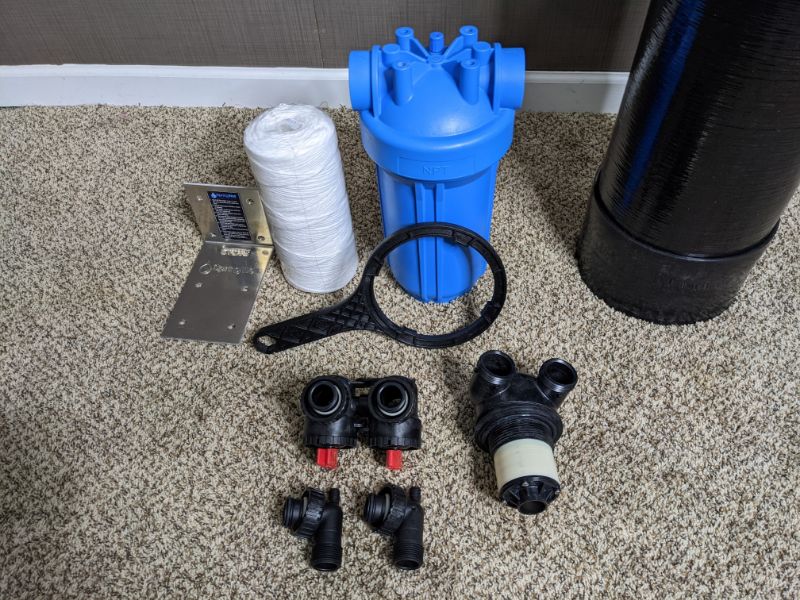
Combined Carbon Filtration
The SpringWell CF is special because unlike other tank-based options, it doesn’t just use a single carbon filter media. Instead, it combines catalytic carbon coconut shell filter media with KDF media to improve its contaminant removal abilities, enabling it to remove contaminants that a more generic activated carbon filter can’t remove alone (like chloramine, PFOS, and PFOA).
For a whole home filtration system, the removal of both chlorine and chloramine adds particular value because it means no matter whether your water is disinfected with either of these chemicals, the SpringWell CF will remove them both, so they won’t affect your water taste and you also can’t breathe them in while you shower. But the system doesn’t just make basic aesthetic improvements to water’s taste – it also removes dangerous trace contaminants like VOCs, PFAS, and pesticides.
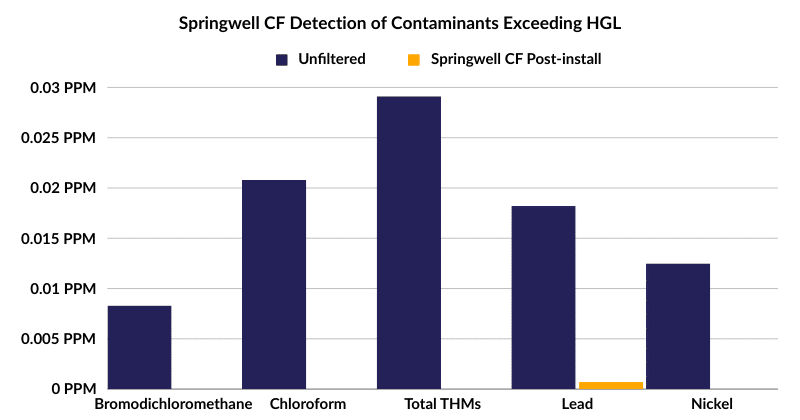
We installed and tested a Springwell CF system in a home in Arvada, Colorado (using mytapscore.com), and the results speak for themselves. Disinfection byproducts – namely THMs – were a major issue in our unfiltered water, and, as we tested from a bathroom sink, we also had issues with trace levels of lead. The CF completely eliminated the disinfection byproducts in our water so they were no longer detected, and it also greatly reduced our water’s lead content to just 0.0007 PPM. See the results below:
| Contaminant | Measurement | Pre-Filtration | Post-Filtration | % Change |
|---|---|---|---|---|
| Barium | PPM | 0.0267 | 0.0158 | -41% |
| Bromodichloromethane | PPB | 0.00832 | 0 | -100% |
| Chloroform | PPB | 0.0208 | 0 | -100% |
| Cobalt | PPM | 0.0011 | 0 | -100% |
| Copper | PPM | 0.222 | 0.0532 | -76% |
| Fluoride | PPM | 0.6 | 0.5 | -17% |
| Lead | PPM | 0.0182 | 0.0007 | -96% |
| Manganese | PPM | 0.002 | 0.0013 | -35% |
| Molybdenum | PPM | 0.0016 | 0 | -100% |
| Nickel | PPM | 0.0125 | 0 | -100% |
| Strontium | PPM | 0.125 | 0.09 | -28% |
| Sulfate | PPM | 36 | 27.2 | -24% |
| Total THMs | PPB | 0.02912 | 0 | -100% |
| Zinc | PPM | 0.917 | 0.255 | -72% |
Thanks to the 6-month money-back guarantee, we felt that we could buy the SpringWell CF risk-free, knowing that we had the opportunity to return it within 6 months if it wasn’t right for our home. The CF is also backed by a lifetime warranty – exactly what we want to see when we’re investing $1,000+ in a whole-house water filter. Plus, the system is made from NSF-certified, USA-made components, so we knew there was a guaranteed quality before we were able to see the unit in person
Superior Performance Efficiency
When it came to performance efficiency, the SpringWell CF exceeded our expectations. We were initially drawn to the unit for the fact that it’s tank-based, which means there’s less of a risk with slow flow rates and maintenance demands are much lower compared to a cartridge-based system. The fact that the CF combines 4 stages (the 2 we’ve already mentioned plus a sediment filter and a final stage that eliminates channeling while still giving the water plenty of contact time with the filter media) and has a starting flow rate of 9 GPM is undeniably impressive.
There are three models to choose from, for 1-3 bathrooms, 4-6 bathrooms, and 7+ bathrooms (with the highest flow rate of 20 GPM), so you never have to compromise with a slower water flow regardless of your home size. We chose the smallest 1-3 bathroom model and the 9 GPM flow rate was plenty for our three-bedroom, two-bathroom home – in fact, we didn’t notice a difference in water pressure or flow once we’d installed it.
| SpringWell CF Configurations | Price |
|---|---|
| CF1: 1-3 Bathrooms | $1016.44 |
| CF4: 4-6 Bathrooms | $1199.66 |
| CF+: 7+ Bathrooms | $1737.20 |
Potential For DIY Install & Easy Maintenance
If you’re familiar with plumbing, you’ll be able to install the SpringWell whole house water filter system yourself. We were up for the task – it took us just under an hour from start to finish, but for the less experienced, the job will likely take around 2-3 hours.
As we mentioned, the tank-based element of this system drew us to it, partly because we could skip the hassle of cartridge changes. The media lasts up to 10 years – much better than the average 3-5-year media lifespan for similar systems – so it was nice to not have to worry about any maintenance after the install aside from occasionally changing the sediment pre-filter.
| Upgrades | Price | Uses |
|---|---|---|
| UV Water Purification System | $1100.99 | Boil water advisory protection |
| Reverse Osmosis Water Filter System | $442.23 | Drinking water |
| Easy Installation Kit (Single Tank) | $157.49 | Clack connectors add-on |
Read the full review: SpringWell Whole House Water Filter System Review

Kind E-1000 Whole House Water Filter
If you prefer to spend less money upfront on a cartridge-based whole house water filtration system, we think the Kind E-1000 Whole House Water Filter can’t be beaten.
Specs
| Price | $776.12 |
| Contaminants Removed | 10+ |
| Capacity | 80,000 gallons |
| Flow Rate | 15 GPM |
| Annual Cost | $120 – $300 |
| App Connectivity | No |
| Warranty | Lifetime (limited) |
Kind Water Systems, formerly Evo Water Systems, is leading the pack in the cartridge-based filtration system category. The best whole house cartridge-based system in Kind’s lineup is the E-1000 Whole House Water Filter, a simplistic, sturdy, two-cartridge system that combines a long-lasting sediment pre-filter and catalytic carbon block filter. As the name suggests, the system uses filter cartridges, which need to be replaced occasionally. So, while the unit is around 30% cheaper than the SpringWell CF and should appeal to folks who prefer to spend less money upfront, it does require more maintenance (in the form of filter changes).
Best For
Anyone with a smaller upfront budget who wants an effective way to remove chlorine and chloramine from their city water.
What We Like
- Thorough contaminant removal
- Upgraded catalytic carbon media
- High 15 GPM flow rate
- Easy install
What We Don’t Like
- No filter test results available online
- Higher annual cost due to cartridge replacements.
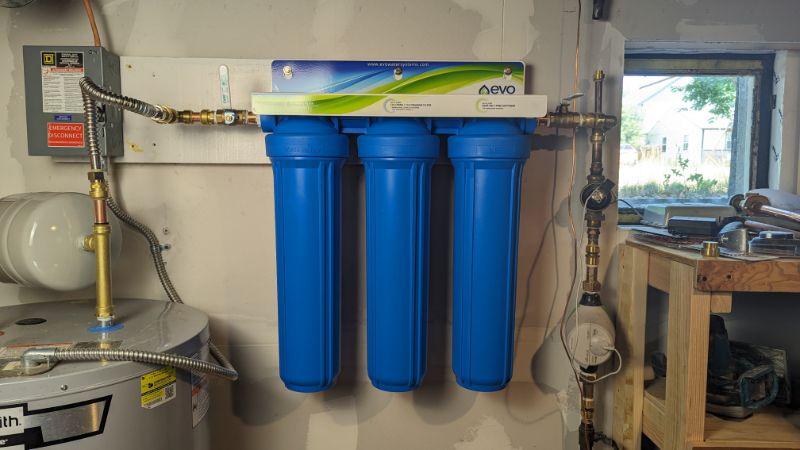
Highly Capable Cartridge Filtration
The Kind E-1000 Whole House Water Filter is one of the most capable cartridge-based whole house water filters we’ve tested, removing tens of contaminants from our water without affecting our flow rate. Cartridge-based systems don’t have to use basic filter media, as proven by the advanced catalytic carbon media used in this system. Like the SpringWell CF, it removes both chlorine and chloramine, as well as VOCs, THMs, and other disinfection byproducts.
The unit ships in just a single size, with a massive 15 GPM flow rate. It’s suitable for homes with up to 6 bathrooms, so one system is inclusive to everyone. We liked the fact that the Kind system’s flow rate was just 5 GPM short of the SpringWell CF’s highest-flow system, but we didn’t have to pay to upgrade for this privilege.
DIY-Friendly Install And Maintenance
We’ll be the first to admit that tank-based whole house water filters like the SpringWell CF don’t have an install process that’s possible for everyone to commit to. But our own experience installing the Kind E-1000 was so smooth and simple that we would recommend that everyone at least unboxes the system and reads the instructions before hiring a professional to do the job for them. Out of the box, the unit had refreshingly few components for us to worry about. It requires only two connections, and there are no fiddly parts and very little potential for making mistakes.
Of course, there’s no denying that maintenance is more of a hassle with cartridge-based systems, but this Kind model was easier to maintain than other similar units we’ve tested. It definitely helps that the system’s sediment pre-filter is washable and reusable, so we were able to save money and avoid buying unnecessary filter replacements in the long run. The cartridges in this whole house water filtration system last for up to 80,000 gallons, or 1 year – much better than the 6-month lifespan of smaller POU cartridge systems.
Read the full review: Kind E-1000 Review

DROP Whole House Backwashing Filter
If you’re on the hunt for a high-end, premium whole house water filter with all the latest tech features, you can’t go wrong with the DROP Backwashing Filter.
This smart water filtration system uses a Jacoby catalytic carbon filter to remove numerous organic solids, including sediment, chlorine, chloramine, pesticides, THMs, and other chemicals. It’s the most expensive on this list, with a starting price of around $2,000 (almost double the price of the SpringWell CF), but it offers unique benefits that you simply won’t find elsewhere, including connection with the DROP Hub and smart leak detection capabilities.
Key Features:
- Comprehensive Jacoby catalytic carbon filtration – The DROP Backwashing Filter uses Jacoby catalytic carbon filtration to remove chloramine, chlorine, THMs, pesticides, and other chemicals commonly found in domestic water supplies.
- Choice of two sizes – There are two system sizes to choose from: the F-15, with 1.5 cubic feet of media and a 5 GPM flow rate, and the F25, with 2.5 cubic feet of media and an 8 GPM flow rate.
- Remote control via smart app – You can connect the DROP Backwashing Filter to the DROP smart app, letting you monitor and control the system from anywhere. You can also receive push notifications, emails, or SMS messages with important system information.
- Smart leak detection –If you pair the system with the DROP Smart Hub and Leak Detectors, you’ll have the peace of mind of having constant knowledge of the state of your plumbing system – and you’ll be the first to know if a leak occurs.
- Long-lasting filter media – The filter media has a lifespan of around 1 million gallons and is periodically refreshed by its backwashing cycle, which flushes the media to remove excess debris and chemicals.
| DROP Backwashing Filter Configurations | Price |
|---|---|
| 1.5 cf w/10x54 vortech tank | $1912.20 |
| 2.5 cf w/13x54 vortech tank | $2498.40 |
Best For:
People who want a smart whole house water filtration system that they can connect up with a smart home system for leak detection, remote monitoring, and more.
Pros:
- It’s good to see that the DROP Backwashing Filter uses catalytic carbon filter media, since this is an upgrade from the less capable activated carbon filter, giving the ability to remove additional contaminants including chloramine.
- Installing anything at your main water line carries the risk of leaks, and we appreciate that you can buy smart leak detectors (at an additional cost) that pair with the system and alert you if water is detected. DROP filters are currently the only filters in the world that can be paired with smart leak detectors.
- If you hate maintenance, we think you’ll be happy with the lack of work involved in keeping this system operating. It backwashes automatically, and there’s no need to replace filter cartridges – like the SpringWell CF, the media in this unit has an excellent 1-million-gallon lifespan.
Cons:
- If you want to enjoy the smart leak detection, you’ll need to spend extra on the DROP smart leak detectors.
- The upfront cost is just under $2,000, so this isn’t a cheap filtration system.

SpringWell WS
The SpringWell WS is our top pick for the best whole house water filter for a well supply.
Specs
| Price | $2204.09+ |
| Contaminants Removed | 3+ |
| Capacity | n/a |
| Flow Rate | 12-20 GPM |
| Annual Cost | <$150 |
| App Connectivity | Yes |
| Warranty | Lifetime |
Best For
Folks on a private well system who want to improve their water quality and safety by targeting a selection of common groundwater contaminants with a chemical-free process.
| SpringWell WS Configurations | Price |
|---|---|
| 1-4 Bathrooms | $2,204.09 |
| 4+ Bathrooms | $2,962.94 |
What We Like
- Chemical-free well water treatment
- Automatically backwashes to minimize maintenance
- Fast 12 GPM+ flow rate
- Excellent upgrade options
What We Don’t Like
- Expensive upfront cost
- You’ll need to source your own fittings and pipings, and the included fittings are plastic

Reliable, Chemical-Free Water Treatment
We’ve tested tens of well water treatment systems, and many of them use chemicals to remove the likes of iron and manganese. The SpringWell WS uses air injection, our preferred method of well water treatment because it’s low-maintenance and chemical-free. Even with our experience in using a variety of systems, we felt more reassured using a system that treated our water with a natural process, with no risk of accidental chemical overuse or leaks. Plus, we didn’t have to worry about additional filtration stages to remove chlorine or other taste-altering chemicals because the WS didn’t add anything to our water.
| Upgrades | Price | Uses |
|---|---|---|
| Salt Based Water Softener System | $1683.59 | Addressing hard water |
| Reverse Osmosis Water Filter System | $442.23 | Drinking water |
| UV Water Purification System | $1100.99 | Microorganism contamination |
Most of the whole house well water filters we’ve looked at were excellent at removing one specific contaminant, but could only remove trace levels of the other common well water impurities. A performance benefit of the SpringWell WS that stood out to us is that it’s an all-rounder, removing up to 8 PPM of hydrogen sulfide, up to 7 PPM of iron, and 1 PPM of manganese, rather than focusing on only one of these contaminants. That meant we were able to comprehensively tackle the taste and aesthetic issues of all three contaminants with a single system. Plus, our water pressure and flow remained consistent thanks to the system’s starting flow rate of 12 GPM.
Below is a table displaying our third-party laboratory testing data for SpringWell WS.
| Contaminant | Measurement | Pre-Filtration | Post-Filtration | % Change |
|---|---|---|---|---|
| Antimony | PPM | 0.0003 | 0.0005 | 66.67% |
| Barium | PPM | 0.051 | 0.003 | -94.12% |
| Boron | PPM | 0.023 | 0.013 | -43.48% |
| Calcium | PPM | 56 | 1.44 | -97.43% |
| Chloride | PPM | 10.5 | 11.4 | 8.57% |
| Chromium (Total) | PPM | 0.001 | 0 | -100.00% |
| Cobalt | PPM | 0.0007 | 0 | -100.00% |
| Copper | PPM | 0.211 | 0.091 | -56.87% |
| Fluoride | PPM | 0 | 0.244 | n/a |
| Hardness | PPM | 220.84 | 5.62 | -97.46% |
| Iron | PPM | 2.37 | 0 | -100.00% |
| Lithium | PPM | 0.079 | 0.003 | -96.20% |
| Magnesium | PPM | 18.2 | 0.414 | -97.73% |
| Manganese | PPM | 0.002 | 0.022 | 1000.00% |
| Molybdenum | PPM | 0.003 | 0.002 | -33.33% |
| Nickel | PPM | 0.009 | 0.0009 | -90.00% |
| Nitrate (as N) | PPM | 0.309 | 0.364 | 17.80% |
| Potassium | PPM | 1.43 | 0.156 | -89.09% |
| Selenium | PPM | 0.002 | 0.001 | -50.00% |
| Silica | PPM | 9.04 | 12.6 | 39.38% |
| Sodium | PPM | 18.8 | 191 | 915.96% |
| Strontium | PPM | 1.08 | 0.015 | -98.61% |
| Sulfate | PPM | 132 | 151 | 14.39% |
| Titanium | PPM | 0.001 | 0.0005 | -50.00% |
| Turbidity | NTU | 0.42 | 0.21 | -50.00% |
| Uranium | PPM | 0.002 | 0.002 | 0.00% |
| Vanadium | PPM | 0.0007 | 0 | -100.00% |
| Zinc | PPM | 0.126 | 0.074 | -41.27% |
Automated Backwashing
Examining the SpringWell WS out of the box gave us a clearer understanding of how the system works. It combines four levels of filtration: a sediment filter, an air injection oxidation filter, greensand media, and an automatic backwash stage. From our testing, we’ve found that greensand is ideal for pairing with air injection because it effectively traps oxidized contaminants and can be backwashed repeatedly, enabling it to be used again and again.
Speaking of backwashing, we were able to use the electronic control valve to set and forget the automatic backwash cycle, which meant we didn’t have to think about manual backwashing or replacing filter cartridges. We only had the sediment filter to remember to replace, and that lasts 6-9 months. So while the WS isn’t completely set-and-forget, it’s as good as it gets.

SoftPro Whole House Upflow Carbon Filter
Based on our research, the SoftPro Whole House Upflow Carbon Filter is the best whole house water filter for small budgets.
This a long-lasting, low-maintenance whole home carbon system can filter 600,000-1,000, 000 gallons of water over approximately five years. It costs around 20% less than the SpringWell CF and is only slightly more expensive than the Kind cartridge-based system on this list – impressive, given that it requires less maintenance thanks to its long-lasting media.
Key Features:
- Catalytic carbon media – This whole house filtration system uses catalytic carbon, which works by using adsorption to trap harmful contaminants in the filter media and prevent them from passing through with the smaller water particles.
- Removes common municipal water contaminants – The SoftPro Whole House Chlorine+ Filter can remove chlorine & chloramines, as well as pesticides, herbicides, heavy metals, and volatile organic compounds (VOCs) from water.
- Additional KDF sponge and sediment pre-filter – Also included with this SoftPro unit is a KDF sponge, which uses oxidation and reduction to remove heavy metals, and a 5-micron sediment pre-filter, which can remove sediment like sand and dirt from water.
- Relatively easy installation – The system comes with an upflow valve and male threaded connections, filter media, and tank. It’s easy for a person with DIY experience to install this system.
Best For:
Folks with small budgets who want to spend less money upfront on a capable tank-based whole house filtration system without compromising on performance quality or durabilitu.
Pros:
- Affordability is the obvious benefit of this SoftPro unit. Costing around $850, it’s one of the cheapest systems we’ve reviewed. Even the upgraded system for larger homes can’t be classed as expensive – it’s still less than $1,000.
- You don’t get a shorter lifespan from this system as a consequence of spending less, either. The media should last between 600,000 and 1,000,000 gallons, or around five years.
- The SoftPro Whole House Chlorine+ Filter doesn’t require power to run. It also produces no wastewater, making it one of the more efficient systems available.
- We appreciate that you can choose between two systems depending on the size of your home, and how much water you need. No need to upgrade if your situation doesn’t call for it.
Cons:
- There’s currently not much specific info on the manufacturer’s website about the filter.
- We also couldn’t find any evidence of third-party testing or certifications.
Read the full review: SoftPro Whole House Upflow Carbon Filter Review

RKIN CBS 5 Micron Sediment Whole House Filter
We’ve found that the RKIN CBS 5 Micron Sediment Whole House Filter is the best whole house sediment filter for well water.
This heavy-duty cartridge filter means business: it has a large 12-month capacity and a maximum flow rate of 20 gallons per minute (GPM), and removes all sediment particles down to 5 microns.
Key Features:
- 5-micron cartridge filtration – The RKIN CBS 5 Micron Sediment Whole House Filter uses a cartridge filter that removes sediment down to 5 microns, including sand, silt, clay, and other debris.
- 12-month filter capacity – The filter lasts up to 12 months before you need to replace it.
- 20 GPM max flow rate – The generous 20 GPM maximum flow rate means you shouldn’t notice a reduction in your water flow regardless of your household size.
- Lifetime warranty & 1-year guarantee – You don’t have to gamble your money when you buy this sediment water filter. It’s backed by a lifetime warranty, and RKIN offers a 1-year satisfaction guarantee that protects your purchase.
Best For:
Anyone who needs to protect their plumbing with a quality, reliable whole house sediment filter that can remove the majority of sediment down to 5 microns.
Pros:
- We appreciate that the RKIN CBS 5 Micron Sediment Whole House Filter is a single-cartridge filter that eliminates the complexities of other sediment filter types. You simply replace the filter once a year to keep it performing as required.
- The 12-month filter life is another benefit of this system. There’s only one cartridge, so maintenance is simple and affordable.
- There’s no better way to protect your home’s plumbing and appliances than with a whole house sediment filter, and this RKIN unit is one of the most reliable and consistent systems we’ve reviewed.
Cons:
- This filter has a relatively low micron rating, so it’ll become quickly clogged if you use it to remove very large sediment of around 50-100+ microns (excess sand, gravel, etc.).
- You’ll have to throw out the old filter cartridge once a year when you replace the filter, so it’s not the lowest-maintenance or most environmentally friendly option.
🧾 How to Select the Best Whole House Water Filtration System
When you’re certain that a whole house water filtration system is the right solution for your situation, your next task is to narrow down your choices from the tens of systems available.
To help you decide, we’ve shared a list of all the considerations we made – which we think you should make too – before you spend your money.
- Your water source (city or well water) – We know that whole-house water filtration systems fall into two main categories: those for city water, and those for well water. Make sure to start by determining your water source, and how this may influence the contaminants you want to remove. In our research, we found that most whole house filters are designed for municipal water supplies, and can remove common city water contaminants, including chlorine, disinfection byproducts, and lead. If you get your water from a private well, a well water filtration system is a better choice for you.
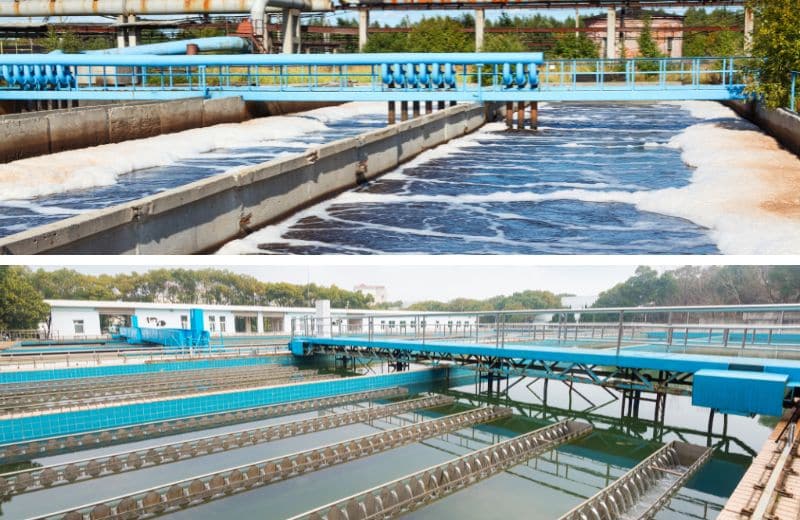
- Water consumption/filter capacity – Filter capacity is the number of gallons of water the media can filter during its lifespan. The higher the water filter capacity, the longer-lasting the system. Not all whole house water filters have the same capacities, and some are designed for greater water demands than others. We outlined all our possible options, noting that the average capacity for a tank-based whole house water filtration system was 600,000-1,000,000 gallons, or 3-5 years, while the average capacity for a cartridge-based whole house filtration system was 80,000 gallons, which equated to around 1 year.
| Brand | Filter Capacity (in gal.) | Flow Rate |
|---|---|---|
| SpringWell CF | 1,000,000 | 9-20 GPM |
| Kind E-1000 | 80,000 | 15 GPM |
| DROP | 1,000,000 | 5-8 GPM |
| SoftPro System | 600K or 1,000,000 | 6-15 GPM |
- Contaminant removal – We regularly test our water quality as part of our testing process, but if you don’t know what’s in your tap water or what you want to remove, start there. Our advice is to make a list of the contaminants you want to remove from your water supply before you start shopping for a whole house water filter system. You can learn about your water quality by either searching online for the most recent Water Quality Report from your local water utility or testing your water using a water test kit, which will give you more comprehensive results that are specific to your water quality as it reaches your home.

- System footprint & available space – We made sure we had plenty of free space to install our chosen filtration systems before purchasing them. Point of entry water filtration systems should be installed somewhere along your main water line. We knew we didn’t just need enough space to store the water filter unit, but also to be able to easily access the unit whenever we had to change a filter or perform system maintenance. The best way to ensure you have enough room? Get out the measuring tape and check, then compare your measurements to your chosen system’s dimensions.
- Micron rating – A whole house water filter’s micron rating is its ability to remove contaminants based on their micron size. We noted that the average micron range for a whole house water filter system is 0.5-50 microns. Micron rating is important to know because it gives you a clearer understanding of what contaminants can be removed by the filtration process, based on their size.
- Budget – We set a budget before we started looking for filters, then made sure to budget accordingly for all the costs involved with operating a whole home system.
| System Type | Average Cost Range |
|---|---|
| Whole House Systems | $1,000 - $4,000+ |
| Well Water Systems | $1,000 - $4,000+ |
| UV Disinfection Systems | $500 - $1,500+ |
| Reverse Osmosis Systems | $4,000 - $10,000+ |
- Water pressure/flow rate – During the reviewing process, we were able to see the difference in filtration speed from one filter to the next. Flow rate and water pressure are particularly important for whole house water filter systems because if a system affects your flow rate, your entire home’s appliances and fixtures will be hindered. The average flow rate of the whole home filtration systems we tested was 8-16 GPM, and we noted that most manufacturers offer at least two system sizes for their whole house filters: a smaller size for most homes, and a larger size, with a faster flow rate, for bigger homes.
You can easily get an estimate of your flow rate by filling a 5-gallon bucket and using the calculator below.
.container { max-width: 400px; margin: 0 auto; padding: 20px; border: 1px solid #ccc; border-radius: 5px; text-align: center; } .text-left { text-align: left; }Enter the number of seconds it took to fill a 5-gallon bucket:
- Filter testing/certifications – The best whole house water filter systems are tested or certified to NSF Standards for their contaminant removal abilities. Certifications aren’t a non-negotiable for us, especially since we know how difficult they are to obtain, but we made a point to prioritize filters that were at least tested to NSF Standards, including NSF/ANSI 42 for the removal of chlorine, taste & odor, NSF/ANSI 53: for the reduction of contaminants with health effects, like lead, and NSF/ANSI 401: for the reduction and removal of emerging contaminants, like pharmaceuticals or PFAS.
- Ease of installation/maintenance – In our experience, the average POE water filtration system is more difficult to install because you’ll need to cut into your main water line, so check that you’re comfortable with the installation process before you click “buy”. If you’re not a confident DIYer, you’ll probably need to pay for a local plumber or handyman to install the system for you. We researched the cost of hiring a professional to install a whole house water filter system and found that the average cost is $250-$600, depending on the scope of the project. We were personally able to save money by doing the install ourselves, but we know that’s not an option for everyone. We learned that maintenance depends on the system you buy, and cartridge-based filters require more frequent maintenance than tank-based systems because they need regular filter changes.
| System Type | Labor | Average Installation Cost |
|---|---|---|
| Whole House Systems | 2 - 5 hours | $200 - $500+ |
| Well Water Systems | 2 - 5 hours | $200 - $600+ |
| UV Disinfection Systems | 2 - 3 hours | $300 - $500+ |
| Reverse Osmosis Systems | 2 - 5 hours | $200 - $500+ |
- Filter media and number of filter stages – Different whole house water filtration systems use different media to filter contaminants out of a water supply. We considered which filter media types we prefer, and our preferred number of filter stages, when shopping around. There were several filter media types that we came across again and again in our research, including catalytic carbon media, KDF media, sediment filtration media, and GAC media. For well water filters, birm or manganese greensand media were most common.
⚖️ How We Determined Which Whole House Water Filtration System Is Best
When we were testing and shortlisting the whole house water filtration systems in this guide, there were tens of factors that we needed to account for. How did we choose the best systems for different preferences and situations? Here, we’ve shared our testing methodology, what questions we asked when determining the suitability of a whole house water filter for different audiences, the advantages of these filters, and more.
💭 Why Buy A Whole House Water Filtration System?
First, we wanted to understand why anyone might need a whole house water filtration system.
We gathered information about the common water quality concerns across the U.S, and examined whether whole house water filters were an adequate solution to removing the problem contaminants.
Here’s what we found.
Water Quality Facts and Figures
We found a number of studies that helped us to understand why drinking water quality is a concern, for both city and well water users. These included:
- A USGS study, which found that at least 23% of private wells had a minimum of one contaminant detected at a concentration of potential health concern. Common contaminants detected included nitrate, arsenic, chloride, uranium, radon, and manganese.
- A study by the Guardian and Consumer Reports, which took samples from municipal water supplies across the U.S. and detected lead, arsenic, and PFAS at “alarming levels”.
- Another USGS study, which estimated that almost half of all tap water supplies in the U.S. contained toxic PFAS “forever chemicals”.
These studies, and others that we found in our research, made it pretty clear to us that our water supplies certainly aren’t up to scratch quality-wise – even city supplies, which are regulated by the EPA and treated to make them “safe to drink”. The data supported our concerns about our nation’s water quality and safety, and not just for drinking. Since some drinking water contaminants vaporize, there’s also the concern of what we might be inhaling from our shower steam. Whole house water filtration systems are the go-to solution for preventing contamination in an entire home’s water supply and preventing the aesthetic issues that arise from certain contaminants in your plumbing system.
When considering both the health effects of many commonly found contaminants and their potential to damage our pipes, fixtures, and appliances, we concluded that every family, including our own, could benefit from a whole house water filter system to improve the safety of their water supply.
👍 Top 5 Advantages of a Whole House Water Filtration System
After testing a few, we identified the following advantages of a whole house water filter system:
- Whole home protection – We felt completely protected with a filtration system that removed contaminants from our water upon entry into our homes, before it traveled through our plumbing system.
- Safer, better-tasting water – Not only did the best whole house water filter systems make our water safe to drink; it also helped us to avoid issues associated with showering in chlorinated water, and damage to our appliances caused by certain aesthetic contaminants.
- Low-maintenance – In our testing, we found whole-house water filter systems to be one of the lowest-maintenance filter categories available today. Many systems needed one filter change per year at most.
- Long-term savings – While we only tested the filters after 6 months, the improvements to our water quality reassured us that the best POE systems would enable us to save money by supporting appliance efficiency and preventing plumbing damage.
- Versatility – We trialed several different system types for different situations, and we appreciate that manufacturers have catered to specific needs (well water treatment, sediment removal, and so on), rather than attempting a one-system-fits-all solution. As a bonus, we could easily integrate the systems with additional water treatment solutions, like UV filters and water softener systems
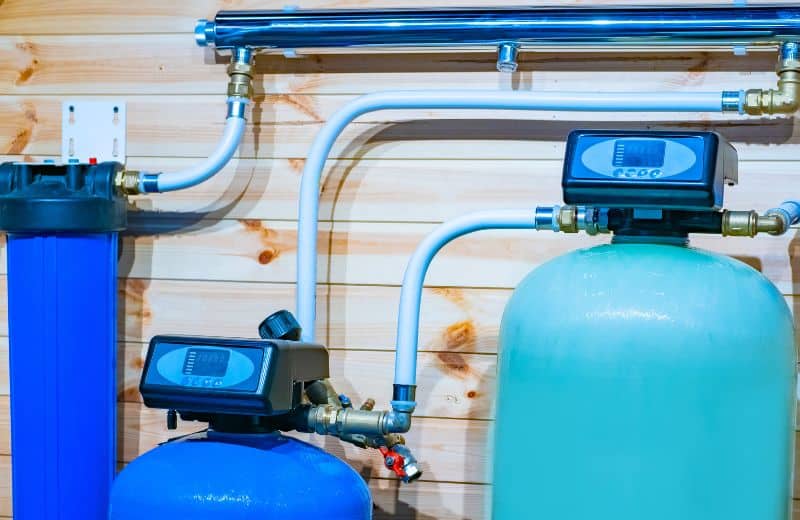
🛒 How to Buy
When buying a whole house water filtration system, there were four key steps that we took. We recommend that you do the same if you want to make the most considered purchase for your situation.
Before we started shopping, we:
- Determined what we needed to remove: Your water quality is unique to your local water source and how it’s treated by your utility (assuming that you’re not on a private well, which is a whole other ball game). Before buying a whole house water filtration system, our first step was to determine how we wanted to further enhance our water quality and improve its safety. Our guide on how to test your water quality at home is a great resource to use at this stage.
- Noted down our desired features: Next, we listed all the features that we prioritized in a POE water filter system. For instance, we needed a flow rate of at least 5-6 GPM for our house size, and we preferred low-maintenance systems that would fit in with our busy lives.
- Set a pre-determined budget: We did this because we wanted to see which options were available within a price range that we deemed to be affordable for most homeowners. This included establishing a budget for annual maintenance costs, since this is often an afterthought for many buyers.
- Take advantage of deals: We spent some extra time researching the internet and looking for deals on our shortlisted filters. If you have more time than us, we’d recommend buying during holidays and annual shopping events like Black Friday, which most water filter manufacturers participate in.
📚 Methodology: How We Picked The Best Whole Home Filtration Systems
Wondering how we selected the water filtration systems that are featured in this guide? Below, we’ve discussed our methodology, including the factors we considered when deciding.
Filter Type & Key Features
First, we took to Google and researched all the whole house water filtration systems we could find. We made a list of these filters, noted their main features, and compared these features.
There are several types of whole house water filtration systems available today, namely single-tank systems and cartridge-based systems. Most systems are intended for city water, but there are also dedicated sediment filters and single-tank POE water filters for well water.
From this early comparison stage, we got a better idea of the filters available and the features offered by the best products, so we were able to prioritize searching for those with adequate flow rates, high-quality filter designs, and other features that set them apart from their competitors.
Contaminant Removal
The whole purpose of a POE filtration system is to reduce contaminants, so, unsurprisingly, system performance was the most important factor we considered when shortlisting the filters for this list.
The right filter for you in terms of contaminant removal completely depends on what your water contains. It’s not usually necessary to look for a filter that can remove as many contaminants as possible – just find one that can remove the contaminants you know your water contains, and the ones you’re concerned about.
Price
Even the best water filter for POE installation isn’t worth discussing if its price is unattainable. For that reason, price was also valued when choosing the filters to feature in this guide.
We knew that whole house water filters were costlier due to their larger capacities for benefits throughout a home’s plumbing system, but it was still important to us that we weren’t overpaying within this filter category, so we did a lot of research into average costs during our research.
Flow Rate
Especially when you’re installing a water filter at the main water line in your home, it needs to deliver a flow rate that won’t disrupt your water pressure.
We’re not talking about a slower flow of water from your faucet or shower head – we’re talking about a possible disruption to your entire home’s water supply if you choose a system with a flow rate that’s too slow. That’s why flow rate was another metric that we used to rank the systems in this guide.
👨🔧 Related: Do whole house water filters reduce water pressure?
Filter Lifespan
We assessed a whole home filter’s lifespan at the same time as assessing its price for one simple reason: the longer the filter lifespan (and therefore the less money you need to spend on maintenance), the better a system’s value for money.
So, filter lifespan was something else we specifically looked for when choosing the filters for this list. We shared both cartridge-based systems and tank-based systems in this guide, knowing that their different lifespan and ongoing spends would appeal to different users.
Installation & Maintenance Requirements
There’s no getting around the fact that it’s more difficult to install a whole house water filter system due to its intended install location. With that said, we know that many people want to be able to install a POE system themselves with relative ease, and most folks would prefer a low-maintenance filter. That’s why we considered installation and maintenance as important metrics when producing this guide.
We prioritized the filters that had simplified installation processes, from their design to the quality of the install instructions and any additional resources (such as online videos). By testing a few of the systems ourselves, we were able to determine their ease of installation first-hand.
| Brand | Media Replacement Frequency | Average Cost/Replacement |
|---|---|---|
| SpringWell CF | 10 years | $330 |
| Kind E-1000 | 9 months | $120-$300 |
| DROP | 10 years | $300 |
| SpringWell WS System | 10 years | $150 |
| SoftPro System | 5 or 10 years | $100 |
| RKIN CBS 5 | 1 year | $50 |
Customer Reviews & Manufacturer Reputation
Our final step involved reading customer reviews to see what real people had to say about certain filters. We used customer reviews to get a better understanding of the general user experience with a filtration system.
Customer feedback tells you much more than a manufacturer will ever reveal – manufacturers obviously want to sell their products, while customers have no bias and will be honest if a filtration system doesn’t live up to their expectations for whatever reason. While most of our decision-making came from our own reviewing process, we considered customer reviews during our initial product research, prioritizing those that had majority positive feedback for important, non-negotiable features.
| Brand | Warranty | Guarantee |
|---|---|---|
| SpringWell | Lifetime | 6 months |
| Kind | Limited lifetime | 120 days |
| DROP | 5 years | 30 days |
| SoftPro | Lifetime | 6 months |
| RKIN | 1 year | 30 days |
❔ Frequently Asked Questions
Is a whole house water filter a good idea?
A whole house water filter is a good idea if you’re prepared to pay more money upfront for this system and commit to the necessary maintenance to benefit from filtered water around your entire home. There are only a few reasons why this filter might be a bad idea – if you rent your home and making changes to your plumbing are against the rental terms, or if you can’t afford to spend $750+ upfront on a system.
Is it worth it to get a home water filtration system?
Yes, we think whole house filtration systems are worth it for anyone who has a large upfront budget and specifically wants to filter the water in their entire home, rather than just their kitchen tap water. A POE water filtration system isn’t worth it for you if you can’t afford the upfront cost or you only want to improve your drinking water quality.
What do whole house water filters cost?
On average, whole house water filters cost $700-$1,800 upfront and around $0-$300 per year to maintain. Upfront cost depends on the system size and complexity, and ongoing costs depend on the type of whole house system you buy (for instance, cartridge-based systems require annual filter changes, while tank-based systems auto-backwash and are virtually maintenance-free).
Where does a whole house filter get installed?
A whole house filter gets installed as close as possible to water’s entry into your home, upstream of your hot water heater. Depending on your available install space, this could be in a closet, garage, basement, or outside (with weather protection if needed).
How long does the average whole house water filter last?
The average whole house water filter lasts 10+ years. You’ll need to maintain the system within this time to help extend its lifespan. This includes replacing the filter cartridges or media as outlined in your user manual.
What’s the difference between whole house water filtration systems and reverse osmosis systems?
The main difference between whole house water filters and reverse osmosis filters is their contaminant removal abilities. Most whole house filters can remove a small selection of the most common drinking water contaminants, while reverse osmosis systems can remove almost all dissolved solids, resulting in pure water.
🤓 About Our Experts
WaterFilterGuru.com’s Founder and Water Filter Specialist Brian Campbell and Senior Editor Laura Shallcross worked on the research and testing to produce this guide. You can learn more about them below.

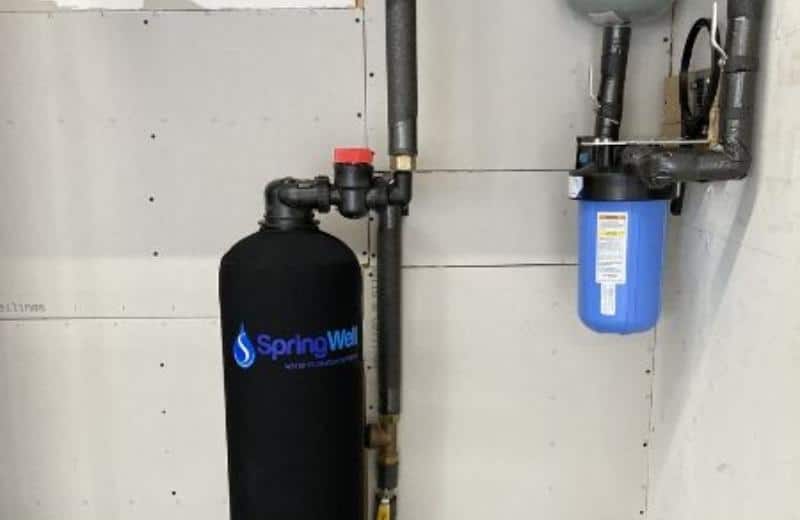
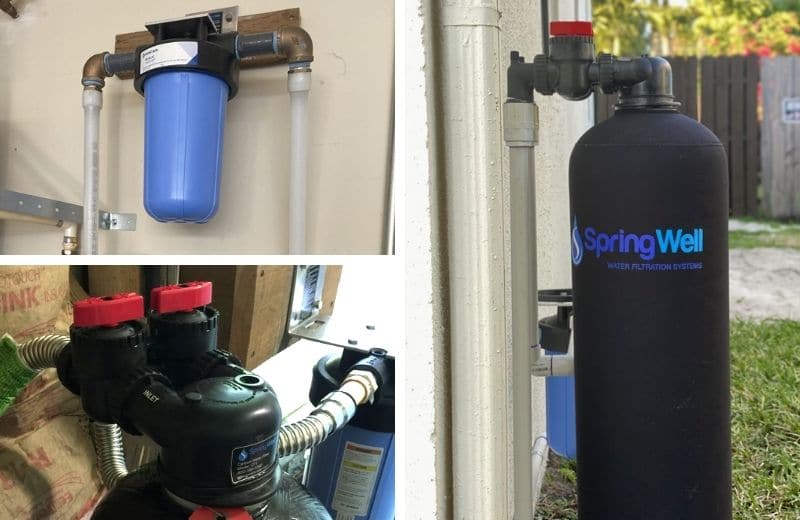

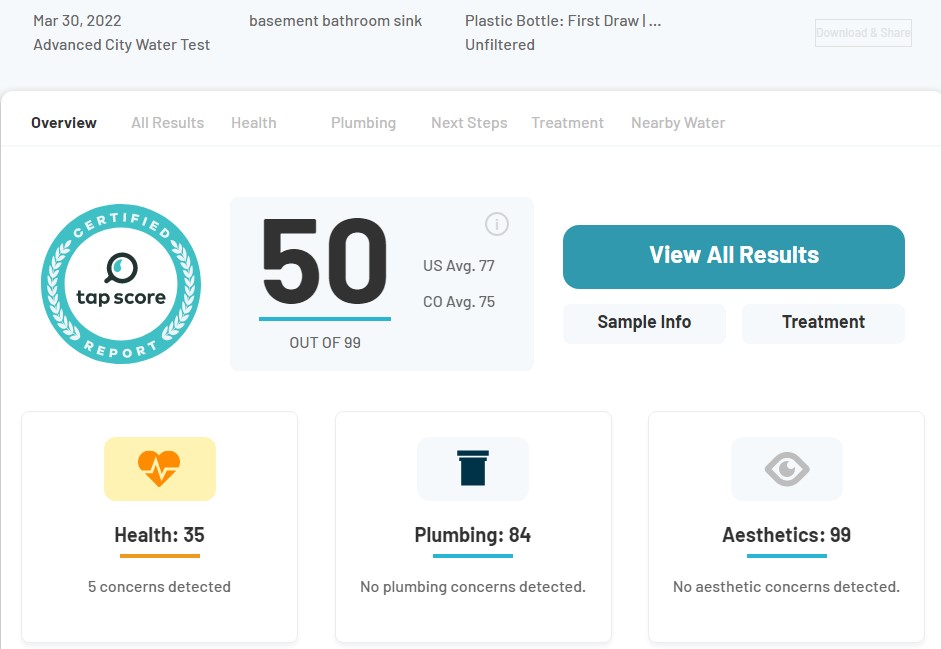
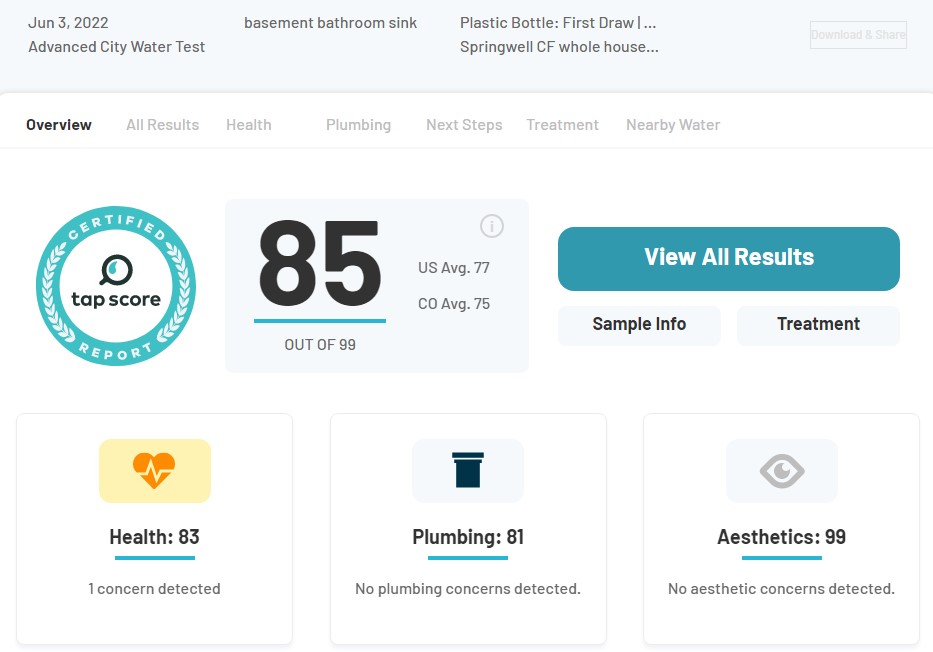
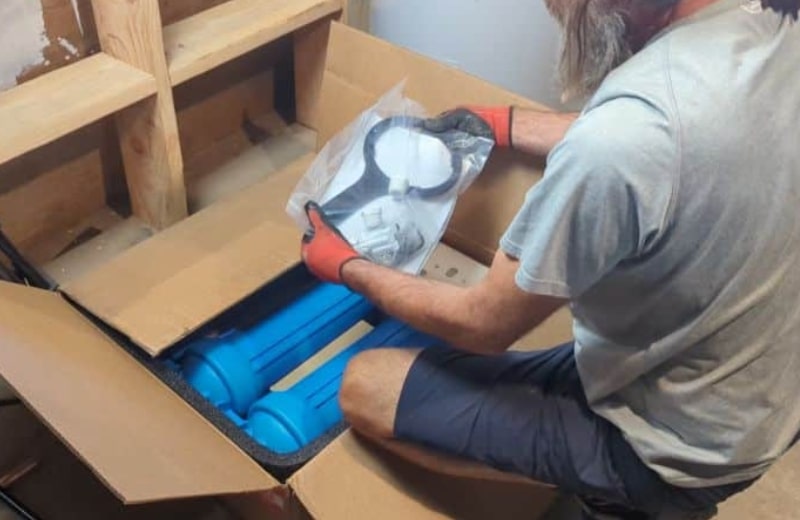
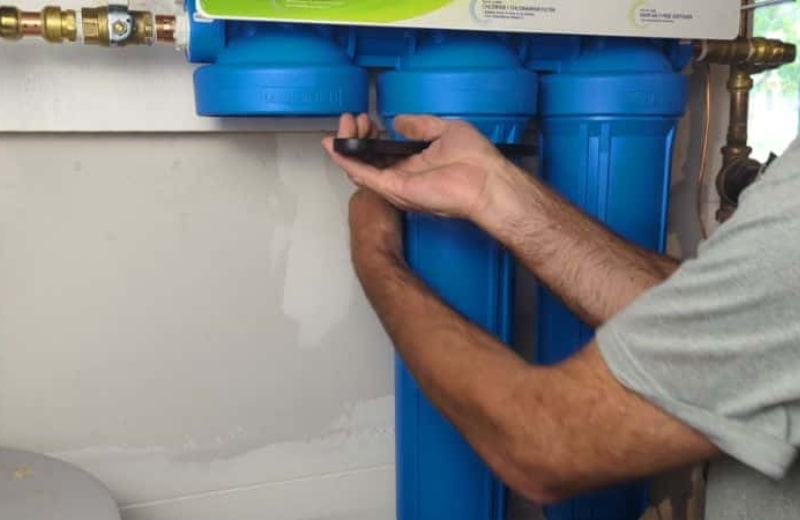
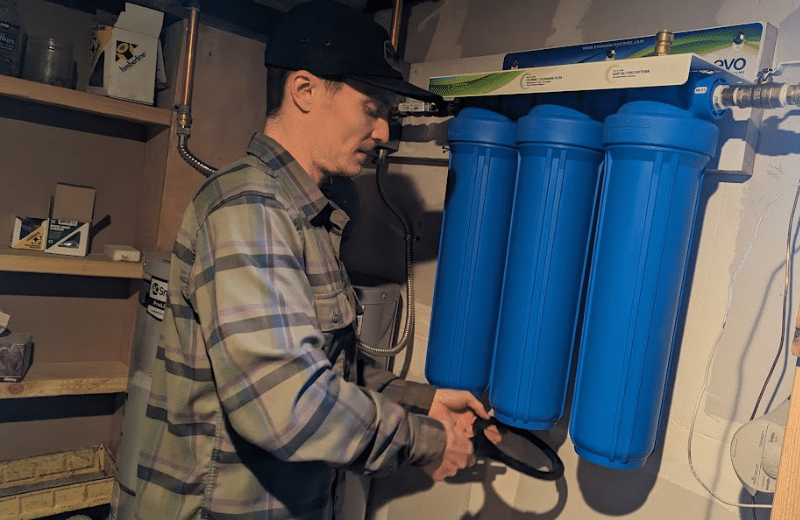
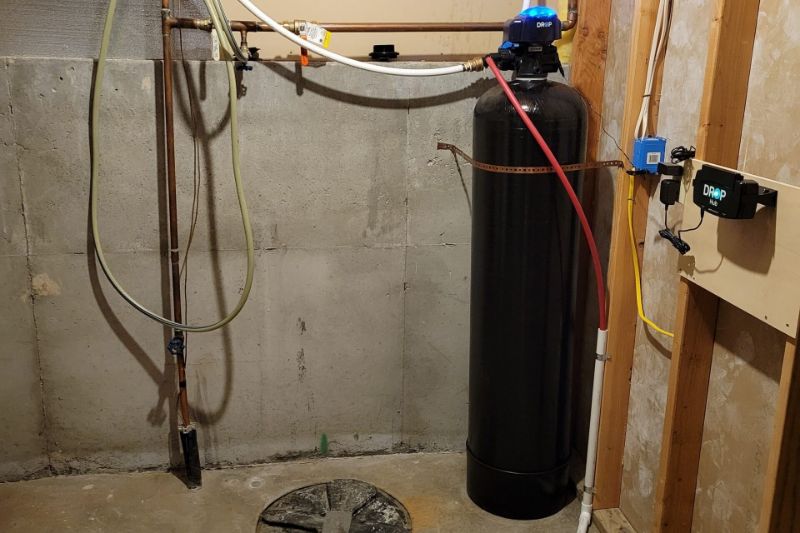
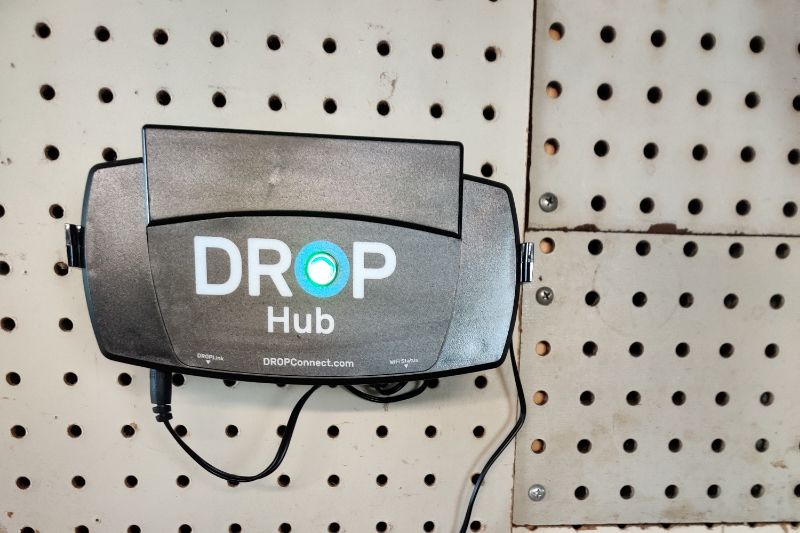

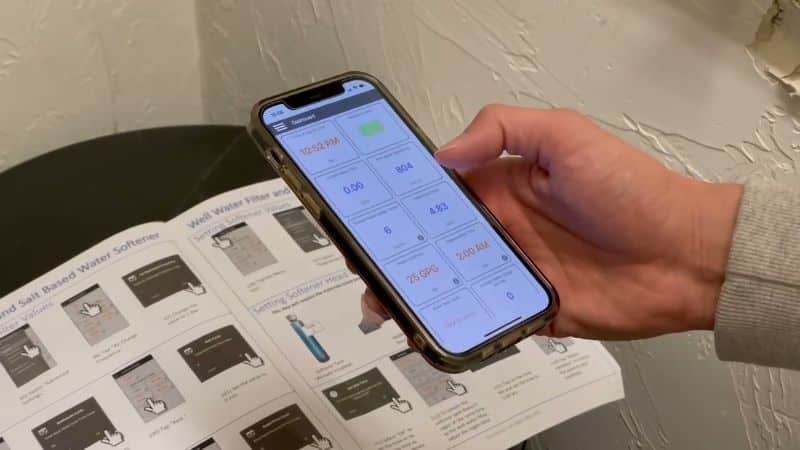

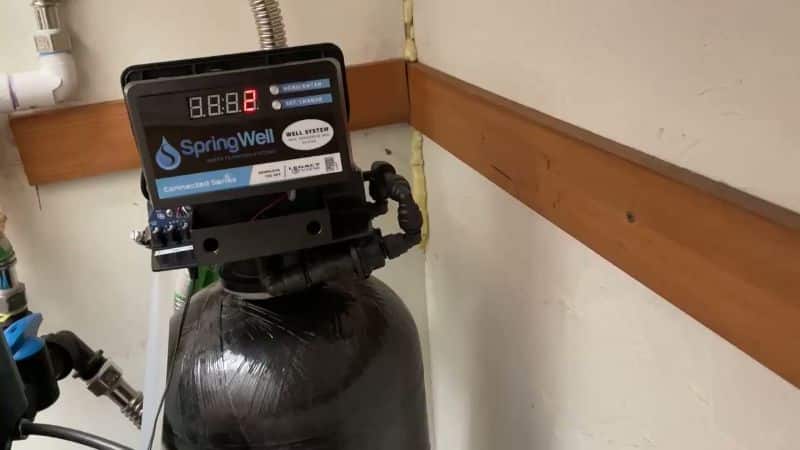
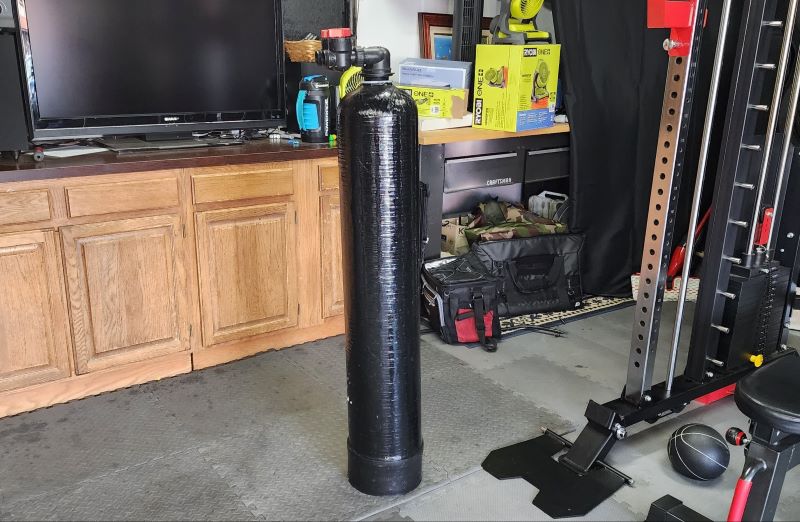







Hello,
The SpringWell System doesn’t remove TDS. That’s a big NO for me!
A TDS reading alone doesn’t tell you if water is safe and healthy or not. For example, purified water with high concentrations of healthy minerals like calcium and magnesium will have a high TDS reading. Learn more here https://waterfilterguru.com/what-is-tds-in-water/